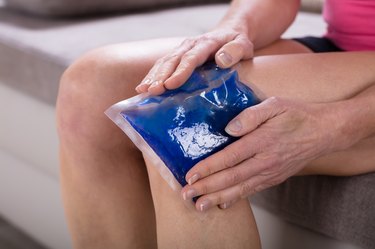
According to the American Academy of Orthopaedic Surgeons, surgeons perform more than 600,000 knee replacement surgeries each year. A knee replacement involves cutting away damaged bone and cartilage from the leg bones — namely the femur, tibia and patella — and replacing it with an artificial joint made of metal alloys, high-grade plastics and polymers. There are several methods for controlling swelling in the operative leg.
Read more: Foods That Help Healing After Knee Surgery
Video of the Day
Video of the Day
Swelling After Knee Replacement
Swelling is common after knee surgery. Cooling the surgery site causes vasoconstriction, or a narrowing of the blood vessels, reducing bloodflow to the area and thereby reducing the swelling.
Cold can also help decrease knee replacement pain. Ice can be applied for 10 to 20 minutes at a time, three to four times per day to help reduce swelling. Sports Medicine North Orthopaedic Surgery, Inc., recommends using ice for at least six weeks after surgery.
Compression for Edema
It is common for a patient undergoing a knee replacement to wear compression stockings after the surgery. These stockings fit snugly around the leg and assist in reducing the swelling from fluid pooling in the leg.
Patients often wear these stockings during prolonged periods of standing or sitting upright, as well as during activity. Activity increases blood flow and will, in turn, increase swelling. Follow your surgeon's instructions for a specific wearing schedule.
Elevate Above Your Heart
Knee replacement patients can reduce swelling by lying down and elevating the leg above the level of the heart. This positioning encourages proper blood flow in and out of the leg.
Exercise for Swelling
Patients should start foot and ankle movement immediately after surgery to promote proper blood flow and reduce the risk of blood clots and swelling, according to the American Academy of Orthopaedic Surgeons. Specific exercises are often prescribed by a physical therapist while the patient is still in the hospital.
Your surgeon might also prescribe a continuous passive motion machine to assist in restoring normal range of motion to the knee. This machine will also promote proper blood flow and reduce swelling.
Walking frequently will help reduce swelling and stiffness. Sports Medicine North Orthopaedic Surgery, Inc., recommends sitting for no more than 45 minutes at a time.
Warnings and Precautions
Swelling in the leg is normal after surgery and can last for up to three to six months. However, swelling after knee replacement can also indicate that an infection is present. Typically, infection causes additional signs and symptoms along with the swelling.
If your knee is becoming redder and more painful, you might have an infection. Other signs include fever greater than 100 F, shaking or chills and drainage from your incision. Call your surgeon if you have these symptoms.
Swelling after knee replacement can also be caused by a blood clot. However, this swelling would more likely be present in your calf, ankle or foot. Blood clots usually cause pain, warm skin and redness which can occur above or below your knee, according to the American Academy of Orthopaedic Surgeons.
Seek immediate medical attention if you suspect you have a blood clot. In some cases, the clot can become dislodged and travel to your lungs. This is a life-threatening emergency which might also be accompanied by shortness of breath and chest pain.
Is this an emergency? If you are experiencing serious medical symptoms, please see the National Library of Medicine’s list of signs you need emergency medical attention or call 911.